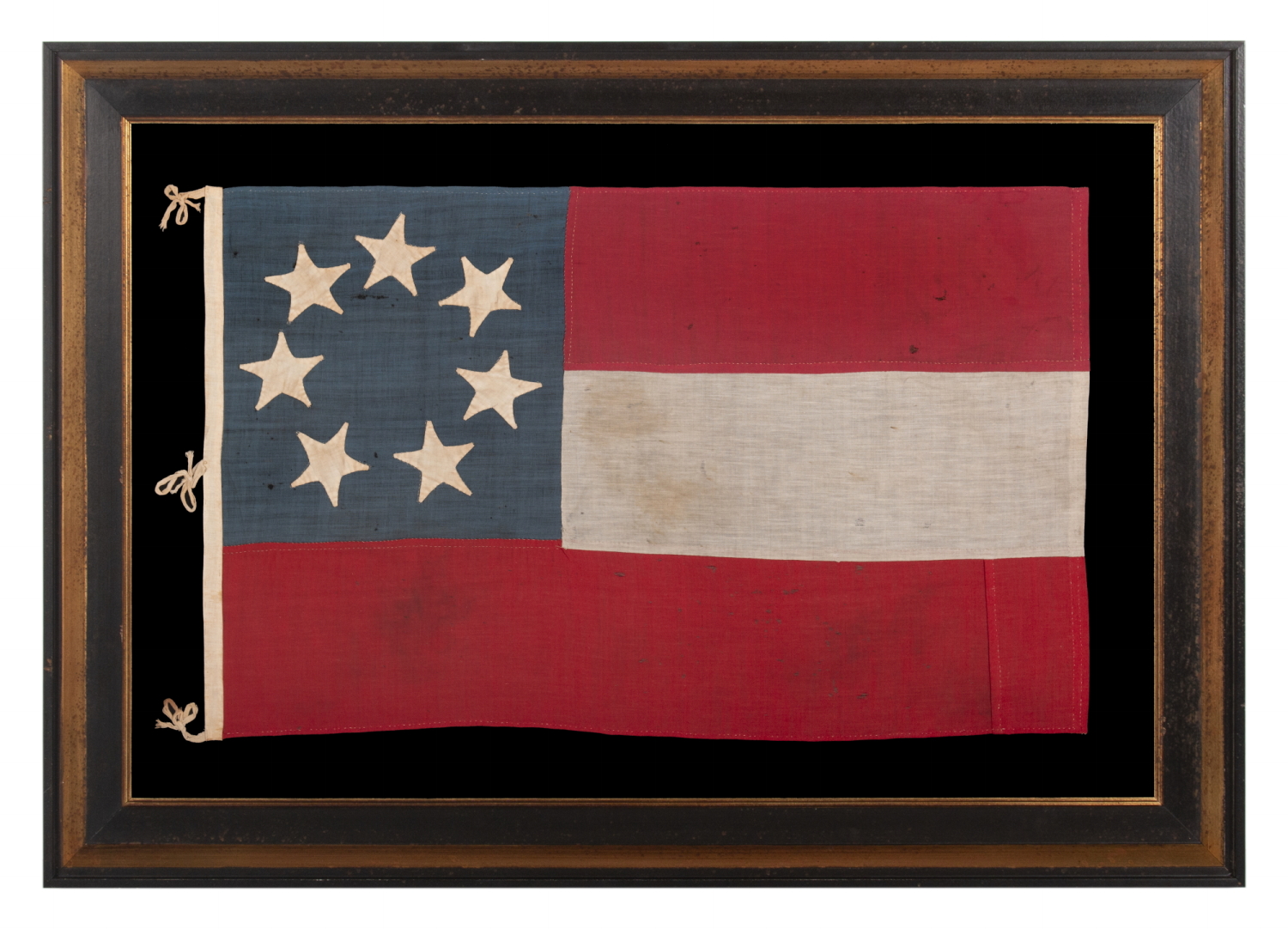
| |
WAR-PERIOD CONFEDERATE FLAG IN THE FIRST NATIONAL PATTERN (a.k.a., STARS & BARS), WITH WREATH OF 7 STARS, IN A TINY SCALE AMONG ITS COUNTERPARTS, PROBABLY MADE FOR USE AS A MILITARY FLANK MARKER OR CAMP COLORS, CIRCA 1861 |
|
| Available: |
Sold |
| Frame Size (H x L): |
32.25" x 45.25" |
| Flag Size (H x L): |
21" x 33.5" |
|
| Description....: |
|
Confederate flag in the First National design, made sometime between the infancy of secession through the opening of the Civil War. Hand-sewn throughout, the flag’s 7 stars are arranged in a circular wreath. Tiny in scale, at approximately 21 x 33.5 inches, the flag is either homemade or produced in a small, cottage industry setting. In either event, it is tiny among all American examples of the Civil War era with pieced-and-sewn construction. Large enough for strong impact, but small enough to easily display in an indoor setting, the scale is attractive to both collectors and one-time buyers alike.
The flag is entirely hand-sewn throughout. The stripes (bars) and canton are made of merino wool. The stars are made of cotton and are double- appliquéd (applied to both sides). The canton and bars are made of wool bunting, joined with flat fell seams. There is a plain weave cotton binding along the hoist, along which three pairs of loosely woven, cotton ties were stitched in order that the flag could be affixed to a staff.
Most likely the flag was produced to be carried as a flank-marker (guidon) or camp colors, in the employment of ground forces. Although larger than Union Army camp colors, the scale would be readily functional in either capacity.
The First National Confederate flag was the first of three official designs. It was adopted by the Confederate Congress on March 4th, 1861, when in session at the temporary capitol of Montgomery, Alabama. The count of 7 stars reflects the initial wave of secession, which occurred approximately one month prior, on February 7th, in conjunction with the adoption of a provisional constitution. As more states seceded, more stars were added, with a total of 11 officially seceding by way of some manner of popular vote, ratified, in most instances, by the respective state legislatures. The States of Missouri and Kentucky were also sometimes included, for a total of 13. The later were accepted by Confederate President Jefferson Davis, despite their being Border States with divided views and less formal achievement of secession.
The First National is the flag also known as the "Stars & Bars." Because they were so alike, use of the Stars & Stripes and the Stars & Bars on the same, smoke-laden battlefields created great confusion. For this reason, the Second National Confederate flag was adopted on May 26th, 1863. This had a completely white field, with the Southern Cross (a.k.a., the Confederate battle flag) serving as its canton. Soldiers and officers disliked this design because it looked too much like a surrender flag, and if given the opportunity, would dip the end in blood to provide color.
36 days before the war’s end, a vertical red bar was added along the fly to create the Third National design. This was known as the “blood-stained banner,” though officially paid homage to France, which lent aid to the South during the war. Note how if you were to replace the first third of the flag with a blue vertical bar, the result would be the French tricolor (the national flag of France).
The most commonly recognized flag of the Confederacy, often called the “Southern Cross,” “the Confederate battle flag,” or the "Flag of the Army of Northern Virginia," was put to use in the fall of 1861 and carried by various Confederate units for the remainder of the war. This was a better signal, being distinctly different from the Stars & Stripes.
Many people are surprised to learn that the Southern Cross was not the national flag of the Confederate States of America. Officially, in rectangular format, it served as the Confederate Navy Jack, flown when a ship was at port or anchor. In either square or rectangular format, it was carried by land forces as a battle flag, and was assigned that generic title partly because it was so often employed in that function by both Robert E. Lee's Army of Northern Virginia, he armies of P.G.T. Beauregard, and others. It also received widespread love in the South because the Second and Third National designs were not particularly admired by Confederate soldiers, the Second for reasons previously stated and the Third because the design was so short-lived.
Mounting: The flag was mounted and framed within our own conservation department, which is led by expert staff. We take great care in the mounting and preservation of flags and have framed thousands of examples.
The background is 100% cotton twill, black in color, that has been washed and treated for colorfastness. The mount was placed in a black-painted, hand-gilded and distressed Italian molding. The glazing is U.V. protective acrylic (Plexiglas).
Condition: There is modest soiling near the hoist end of the white bar, and in two locations in the lower, red bar, accompanied by minor soiling elsewhere. There is minor mothing throughout, accompanied by a minor, lateral tear, with associated loss, in the canton. |
|
|
|
| Collector Level: |
Advanced Collectors and the Person with Everything |
|
| Flag Type: |
|
|
| Star Count: |
07 |
|
| Earliest Date of Origin: |
1861 |
|
| Latest Date of Origin: |
1861 |
|
| State/Affiliation: |
The Confederacy |
|
| War Association: |
1861-1865 Civil War |
|
| Price: |
SOLD |
|
| |
Views: 1343 |
|
|
|

